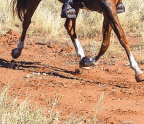SURVEILLANCE DEWORMING made simple

If you were to provide horse owners with scientifically sound advice on how to protect current and future generations of horses from parasites, while saving themselves money in the process, you’d think most would enthusiastically adopt those recommendations. But, for some reason, that hasn’t been the case when it comes to parasite control.
For at least a decade, we’ve known that targeted deworming programs---which use regular fecal egg counts (FEC) to identify horses that need treatment---are far superior to the traditional calendar-based methods, in which each horse in a herd is treated every eight weeks. Not only is the old system financially wasteful, but it increases the risk that parasites on the property will become resistant to a particular anthelmintic, rendering any product containing that chemical ineffective on that farm for years and possibly forever. (For more on this issue, see “How Resistance Develops,” page 42.)
FEC-based targeted deworming, sometimes called surveillance deworming, identifies the horses in a herd that are shedding significant amounts of parasite eggs and treats only those horses with the appropriate products on a schedule dictated by their response to the treatment. It’s an approach that saves money---because many horses will need deworming much less frequently---and reduces the risk of resistance within the parasite population. It’s the right thing to do for yourself, your horse and the equestrian community at large.
Yet, according to the United States Department of Agriculture’s National Animal Health Monitoring System (USDA-NAHMS) 2015 study, only 5.5 percent of farms with horses age 4 and older tested manure for parasite eggs
You’re reading a preview, subscribe to read more.
Start your free 30 days





